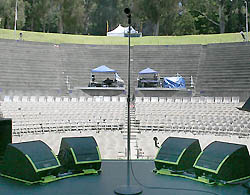
Bi-amplified or Passive?
Most loudspeakers originally included built-in passive, high-power crossover networks to split the amplified signal and send lows to the woofer and the highs to the horn.
Today, most two-way loudspeakers can be bi-amped, powering woofer and horn with their own amp channels, with each amp channel filtered for the frequencies its driver reproduces with an active or line-level crossover. Not only are HF horns several times more efficient than LF cones, they also require less energy due to their portion of the frequency spectrum.
The advantage of bi-amped floor monitors is that when they’re pounded with kick drum or bass, the LF amplifier can peak without distorting or clipping the HF amp and its horn.
If you never need loud wedges in your venue or for your band, passive wedges can save money by both halving the number of amp channels and eliminating active crossovers.
A hybrid approach would be to use a number of passive wedges, while also supplying a couple of beefier bi-amped wedges for the drummer and bass player, as well as for the side-fills. There are many wedges that sound very good run passively on a single amp channel.
My favorite is the EAW SM200, which can also be switched to bi-amp operation, and is a staple of many performing arts centers. Another favorite is the Turbosound TXD-12M passive-only floor monitor.
Self-Powered
Like all self-powered loudspeakers, self-powered floor monitors provide advantages and challenges. After the missing amplifier rack, the great advantage is that, as a closed system, the combination of drivers, processing and power in a single product provides extremely consistent results.

The accompanying challenge is that instead of a loudspeaker cable, each wedge must be supplied with its own signal from the monitor console and its own AC from a power distro. Solutions involving Edison-to-PowerCon cables with XLR stingers taped onto them, distributed from AC quad-boxes and male XLR fan-outs or sub-snakes are a common solution.
Meyer Sound provides a VEAM multi-pin option for most of their self-powered products that puts AC power, audio and RMS data into a single connection, and the company’s recent self-powered MJF-212 employs dual 12-inch woofers and a 40-degree conical horn to minimize interaction with adjacent monitor mixes.
